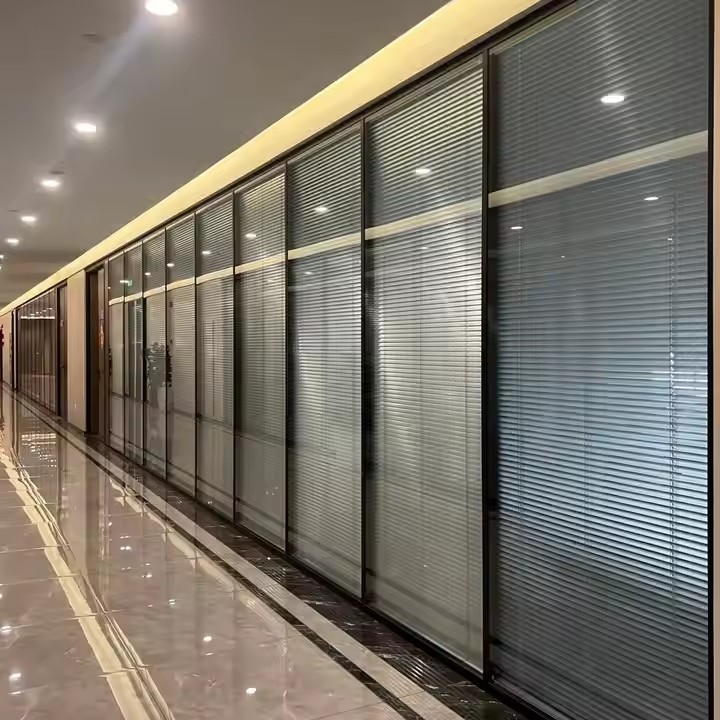- Material Selection: The Physical Foundation of Stability
The choice of base material is the primary determinant of a folding door’s stability. Different materials exhibit distinct physical properties that directly affect deformation under changes in temperature and humidity. To ensure structural integrity, folding doors must use rigid, high-performance materials—preferably premium-grade—to maintain strength and durability after installation.
Solid wood must undergo rigorous degreasing and drying, with a moisture content controlled between 8% and 12%. It should also adopt finger-jointing or laminated structures. Finger-jointing connects short wood segments end to end, dispersing stress along the grain and reducing the warping probability by over 70% compared to whole wood panels. Laminated timber arranges adjacent grain directions in alternating patterns, neutralizing shrinkage forces. Experiments show that after three cycles of wet-heat testing (from -10°C to 60°C), high-quality laminated timber deformed only one-third as much as standard solid wood. Solid wood enhances building stability and prolongs the service life of doors and windows.
Among composite panels, multi-layer plywood is preferred for its cross-laminated structure. The surface and core use woods of different densities, forming a stress-balancing system under hot pressing. Even under ±15% humidity fluctuations, the flatness deviation remains within 0.5mm/m. PVC foam boards, while offering excellent moisture resistance, require added fiberglass reinforcement to improve low-temperature brittleness and prevent frame cracking in environments below -5°C.

- Structural Optimization: The Key to Mechanical Balance
Stability in folding door design hinges on achieving mechanical balance, which must be coordinated across the frame structure, hinge layout, and guiding system.
In terms of frame structure, reinforcement ribs shaped like “I” or “Z” should be used. For example, a 1.4mm thick aluminum alloy frame with 2mm diagonal bracing ribs can increase bending resistance by 40%. For folding doors wider than 3 meters, a continuous steel header beam should be installed at the top, connected to the building via embedded anchors. This distributes the door’s weight to the main structure, preventing long-term deformation of the frame.
Hinges should follow the “three-point load-bearing principle”—spacing between the top and bottom hinges should be evenly divided by the middle hinge. For a 2.4-meter-high door panel, with a 1.6-meter distance between top and bottom hinges, the middle hinge should be positioned at 800mm. This keeps hinge load deviation under 5%. Hinge pins should be made from 45-gauge steel with a diameter ≥12mm, paired with bronze bushings for self-lubrication, ensuring the door remains level despite friction forces.
The guiding system must control both horizontal and vertical movement. Bottom guide rollers should use a dual-wheel design, with a wheelbase ≥80mm, and adjustable eccentric shafts to offset floor unevenness, ensuring vertical sliding. The top guide track should have a lateral clearance of 5–8mm, allowing smooth folding while limiting side sway to under 3mm.
- Hardware System: Ensuring Dynamic Stability
Hardware components are essential for the dynamic stability of folding doors, and must support load-bearing, wear resistance, and adjustability.
Hinges must be rated for the door panel’s weight, with each set supporting at least 1.5× the door’s weight. For glass folding doors, concealed hinges made of 304 stainless steel are recommended. These use a four-bar linkage mechanism for smooth 0–90° opening. Hinge bushings should be filled with PTFE grease to maintain integrity after 50,000 opening/closing cycles.
The wear resistance of the track system is key for long-term stability. Tracks must be surface-hardened with a Rockwell hardness ≥ HRC58 and a coefficient of friction ≤ 0.15. For heavy-traffic areas like commercial spaces, use U-shaped track grooves with wear strips made from ultra-high-molecular-weight polyethylene (UHMWPE)—a material over three times more wear-resistant than nylon—extending track life to over 10 years.
Adjustment systems must allow multi-dimensional compensation. Hinges should include adjustment screws for horizontal, vertical, and depth directions, each with a range of at least ±3mm, to fine-tune the vertical alignment after installation. Bottom guide wheels must feature a height adjustment mechanism via an eccentric nut, offering ±2mm compensation to maintain a flat door alignment with a tolerance ≤1mm when fully closed.
- Installation Process: The Final Step to Realizing Stability
Even with a perfect design, poor installation can compromise stability. Precision must be maintained across measurement, anchoring, and calibration phases.
In measurement, account for structural irregularities. Measure door opening width at the top, middle, and bottom, and use the maximum as the manufacturing reference. Leave 10–15mm for installation clearance. For openings over 3 meters tall, measure diagonal deviation—if over 5mm, level the wall before installation.

Use a multi-point anchoring method, ensuring frame-to-wall connection points are spaced ≤600mm apart, with reinforced plates at corners. Expansion bolts should be embedded ≥80mm deep. For lightweight walls, use through-wall bolts with steel backing plates, spreading load over an area ≥100mm × 100mm to prevent loosening over time.
During calibration, use professional tools. A 2-meter straightedge should show a vertical deviation ≤1mm/m, and a feeler gauge should confirm gap uniformity within 0.5mm. After adjustments, apply sealant at hinge axes and track joints to block moisture and eliminate micro-vibration from loose fittings.

